
eino
The ultimate LLM/AI application development framework in Golang.
Stars: 7509
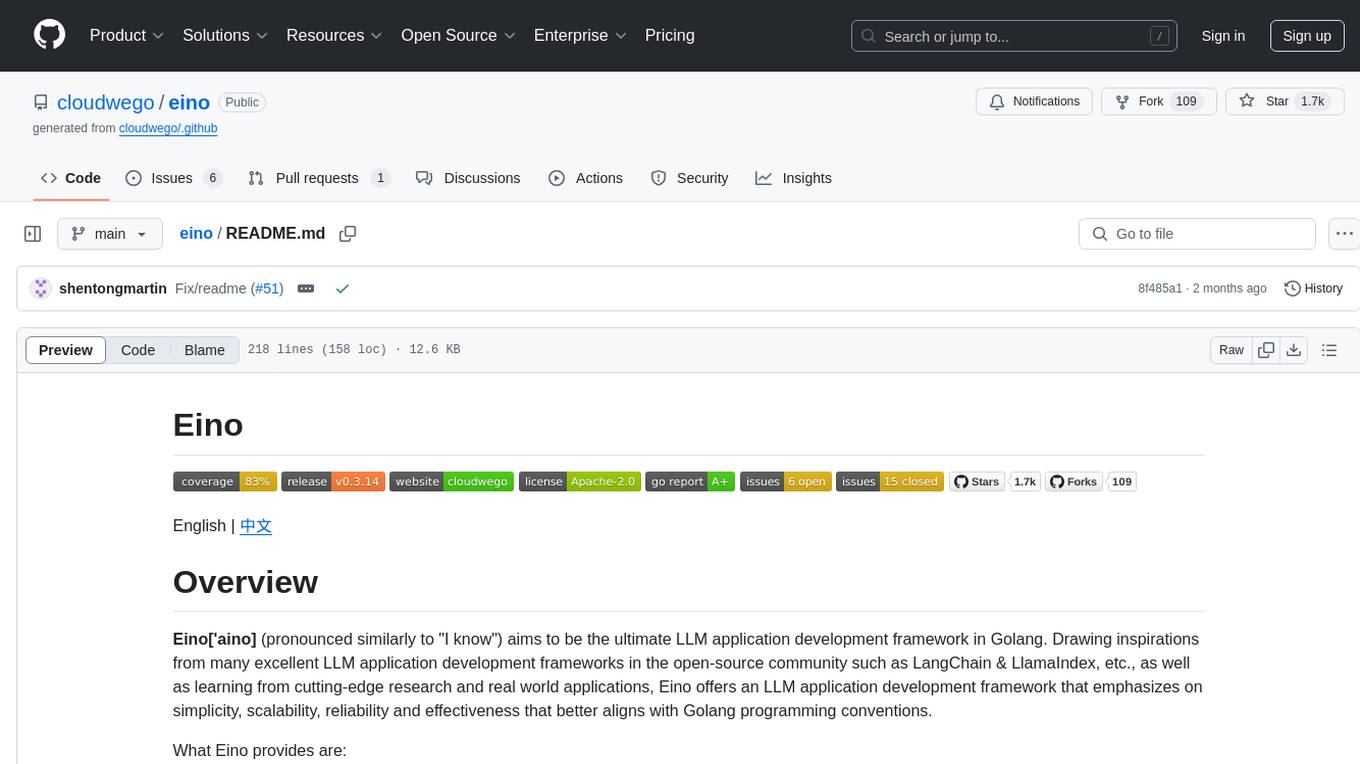
Eino is an ultimate LLM application development framework in Golang, emphasizing simplicity, scalability, reliability, and effectiveness. It provides a curated list of component abstractions, a powerful composition framework, meticulously designed APIs, best practices, and tools covering the entire development cycle. Eino standardizes and improves efficiency in AI application development by offering rich components, powerful orchestration, complete stream processing, highly extensible aspects, and a comprehensive framework structure.
README:
English | 中文
Eino['aino] (pronounced similarly to "I know") aims to be the ultimate LLM application development framework in Golang. Drawing inspirations from many excellent LLM application development frameworks in the open-source community such as LangChain & LlamaIndex, etc., as well as learning from cutting-edge research and real world applications, Eino offers an LLM application development framework that emphasizes on simplicity, scalability, reliability and effectiveness that better aligns with Golang programming conventions.
What Eino provides are:
- a carefully curated list of component abstractions and implementations that can be easily reused and combined to build LLM applications
- a powerful composition framework that does the heavy lifting of strong type checking, stream processing, concurrency management, aspect injection, option assignment, etc. for the user.
- a set of meticulously designed API that obsesses on simplicity and clarity.
- an ever-growing collection of best practices in the form of bundled flows and examples.
- a useful set of tools that covers the entire development cycle, from visualized development and debugging to online tracing and evaluation.
With the above arsenal, Eino can standardize, simplify, and improve efficiency at different stages of the AI application development cycle:

Use a component directly:
model, _ := openai.NewChatModel(ctx, config) // create an invokable LLM instance
message, _ := model.Generate(ctx, []*Message{
SystemMessage("you are a helpful assistant."),
UserMessage("what does the future AI App look like?")})Of course, you can do that, Eino provides lots of useful components to use out of the box. But you can do more by using orchestration, for three reasons:
- orchestration encapsulates common patterns of LLM application.
- orchestration solves the difficult problem of processing stream response by the LLM.
- orchestration handles type safety, concurrency management, aspect injection and option assignment for you.
Eino provides three set of APIs for orchestration
| API | Characteristics and usage |
|---|---|
| Chain | Simple chained directed graph that can only go forward. |
| Graph | Cyclic or Acyclic directed graph. Powerful and flexible. |
| Workflow | Acyclic graph that supports data mapping at struct field level. |
Let's create a simple chain: a ChatTemplate followed by a ChatModel.
chain, _ := NewChain[map[string]any, *Message]().
AppendChatTemplate(prompt).
AppendChatModel(model).
Compile(ctx)
chain.Invoke(ctx, map[string]any{"query": "what's your name?"})Now let's create a graph that uses a ChatModel to generate answer or tool calls, then uses a ToolsNode to execute those tools if needed.
graph := NewGraph[map[string]any, *schema.Message]()
_ = graph.AddChatTemplateNode("node_template", chatTpl)
_ = graph.AddChatModelNode("node_model", chatModel)
_ = graph.AddToolsNode("node_tools", toolsNode)
_ = graph.AddLambdaNode("node_converter", takeOne)
_ = graph.AddEdge(START, "node_template")
_ = graph.AddEdge("node_template", "node_model")
_ = graph.AddBranch("node_model", branch)
_ = graph.AddEdge("node_tools", "node_converter")
_ = graph.AddEdge("node_converter", END)
compiledGraph, err := graph.Compile(ctx)
if err != nil {
return err
}
out, err := compiledGraph.Invoke(ctx, map[string]any{"query":"Beijing's weather this weekend"})Now let's create a workflow that flexibly maps input & output at the field level:
type Input1 struct {
Input string
}
type Output1 struct {
Output string
}
type Input2 struct {
Role schema.RoleType
}
type Output2 struct {
Output string
}
type Input3 struct {
Query string
MetaData string
}
var (
ctx context.Context
m model.BaseChatModel
lambda1 func(context.Context, Input1) (Output1, error)
lambda2 func(context.Context, Input2) (Output2, error)
lambda3 func(context.Context, Input3) (*schema.Message, error)
)
wf := NewWorkflow[[]*schema.Message, *schema.Message]()
wf.AddChatModelNode("model", m).AddInput(START)
wf.AddLambdaNode("lambda1", InvokableLambda(lambda1)).
AddInput("model", MapFields("Content", "Input"))
wf.AddLambdaNode("lambda2", InvokableLambda(lambda2)).
AddInput("model", MapFields("Role", "Role"))
wf.AddLambdaNode("lambda3", InvokableLambda(lambda3)).
AddInput("lambda1", MapFields("Output", "Query")).
AddInput("lambda2", MapFields("Output", "MetaData"))
wf.End().AddInput("lambda3")
runnable, err := wf.Compile(ctx)
if err != nil {
return err
}
our, err := runnable.Invoke(ctx, []*schema.Message{
schema.UserMessage("kick start this workflow!"),
})Now let's create a 'ReAct' agent: A ChatModel binds to Tools. It receives input Messages and decides independently whether to call the Tool or output the final result. The execution result of the Tool will again become the input Message for the ChatModel and serve as the context for the next round of independent judgment.
We provide a complete implementation for ReAct Agent out of the box in the flow package. Check out the code here: flow/agent/react
Our implementation of ReAct Agent uses Eino's graph orchestration exclusively, which provides the following benefits out of the box:
- Type checking: it makes sure the two nodes' input and output types match at compile time.
- Stream processing: concatenates message stream before passing to chatModel and toolsNode if needed, and copies the stream into callback handlers.
- Concurrency management: the shared state can be safely read and written because the StatePreHandler is concurrency safe.
- Aspect injection: injects callback aspects before and after the execution of ChatModel if the specified ChatModel implementation hasn't injected itself.
- Option assignment: call options are assigned either globally, to specific component type or to specific node.
For example, you could easily extend the compiled graph with callbacks:
handler := NewHandlerBuilder().
OnStartFn(
func(ctx context.Context, info *RunInfo, input CallbackInput) context.Context) {
log.Infof("onStart, runInfo: %v, input: %v", info, input)
}).
OnEndFn(
func(ctx context.Context, info *RunInfo, output CallbackOutput) context.Context) {
log.Infof("onEnd, runInfo: %v, out: %v", info, output)
}).
Build()
compiledGraph.Invoke(ctx, input, WithCallbacks(handler))or you could easily assign options to different nodes:
// assign to All nodes
compiledGraph.Invoke(ctx, input, WithCallbacks(handler))
// assign only to ChatModel nodes
compiledGraph.Invoke(ctx, input, WithChatModelOption(WithTemperature(0.5))
// assign only to node_1
compiledGraph.Invoke(ctx, input, WithCallbacks(handler).DesignateNode("node_1"))-
Encapsulates common building blocks into component abstractions, each have multiple component implementations that are ready to be used out of the box.
- component abstractions such as ChatModel, Tool, ChatTemplate, Retriever, Document Loader, Lambda, etc.
- each component type has an interface of its own: defined Input & Output Type, defined Option type, and streaming paradigms that make sense.
- implementations are transparent. Abstractions are all you care about when orchestrating components together.
-
Implementations can be nested and captures complex business logic.
- ReAct Agent, MultiQueryRetriever, Host MultiAgent, etc. They consist of multiple components and non-trivial business logic.
- They are still transparent from the outside. A MultiQueryRetriever can be used anywhere that accepts a Retriever.
- Data flows from Retriever / Document Loaders / ChatTemplate to ChatModel, then flows to Tools and parsed as Final Answer. This directed, controlled flow of data through multiple components can be implemented through graph orchestration.
- Component instances are graph nodes, and edges are data flow channels.
- Graph orchestration is powerful and flexible enough to implement complex business logic:
- type checking, stream processing, concurrency management, aspect injection and option assignment are handled by the framework.
- branch out execution at runtime, read and write global state, or do field level data mapping using workflow(currently in alpha stage).
- Stream processing is important because ChatModel outputs chunks of messages in real time as it generates them. It's especially important with orchestration because more components need to handle streaming data.
- Eino automatically concatenates stream chunks for downstream nodes that only accepts non-stream input, such as ToolsNode.
- Eino automatically boxes non stream into stream when stream is needed during graph execution.
- Eino automatically merges multiple streams as they converge into a single downward node.
- Eino automatically copies stream as they fan out to different downward node, or is passed to callback handlers.
- Orchestration elements such as branch and state handlers are also stream aware.
- With these streaming processing abilities, the streaming paradigms of components themselves become transparent to the user.
- A compiled Graph can run with 4 different streaming paradigms:
| Streaming Paradigm | Explanation |
|---|---|
| Invoke | Accepts non-stream type I and returns non-stream type O |
| Stream | Accepts non-stream type I and returns stream type StreamReader[O] |
| Collect | Accepts stream type StreamReader[I] and returns non-stream type O |
| Transform | Accepts stream type StreamReader[I] and returns stream type StreamReader[O] |
- Aspects handle cross-cutting concerns such as logging, tracing, metrics, etc., as well as exposing internal details of component implementations.
- Five aspects are supported: OnStart, OnEnd, OnError, OnStartWithStreamInput, OnEndWithStreamOutput.
- Developers can easily create custom callback handlers, add them during graph run via options, and they will be invoked during graph run.
- Graph can also inject aspects to those component implementations that do not support callbacks on their own.
The Eino framework consists of several parts:
-
Eino(this repo): Contains Eino's type definitions, streaming mechanism, component abstractions, orchestration capabilities, aspect mechanisms, etc.
-
EinoExt: Component implementations, callback handlers implementations, component usage examples, and various tools such as evaluators, prompt optimizers.
-
Eino Devops: visualized developing, visualized debugging etc.
-
EinoExamples is the repo containing example applications and best practices for Eino.
For learning and using Eino, we provide a comprehensive Eino User Manual to help you quickly understand the concepts in Eino and master the skills of developing AI applications based on Eino. Start exploring through the Eino User Manual now!
For a quick introduction to building AI applications with Eino, we recommend starting with Eino: Quick Start
- Go 1.18 and above.
- Eino relies on kin-openapi 's OpenAPI JSONSchema implementation. In order to remain compatible with Go 1.18, we have fixed kin-openapi's version to be v0.118.0.
If you discover a potential security issue in this project, or think you may have discovered a security issue, we ask that you notify Bytedance Security via our security center or vulnerability reporting email.
Please do not create a public GitHub issue.
- How to become a member: COMMUNITY MEMBERSHIP
- Issues: Issues
- Lark: Scan the QR code below with Register Feishu to join our CloudWeGo/eino user group.
This project is licensed under the Apache-2.0 License.
For Tasks:
Click tags to check more tools for each tasksFor Jobs:
Alternative AI tools for eino
Similar Open Source Tools

eino
Eino is an ultimate LLM application development framework in Golang, emphasizing simplicity, scalability, reliability, and effectiveness. It provides a curated list of component abstractions, a powerful composition framework, meticulously designed APIs, best practices, and tools covering the entire development cycle. Eino standardizes and improves efficiency in AI application development by offering rich components, powerful orchestration, complete stream processing, highly extensible aspects, and a comprehensive framework structure.
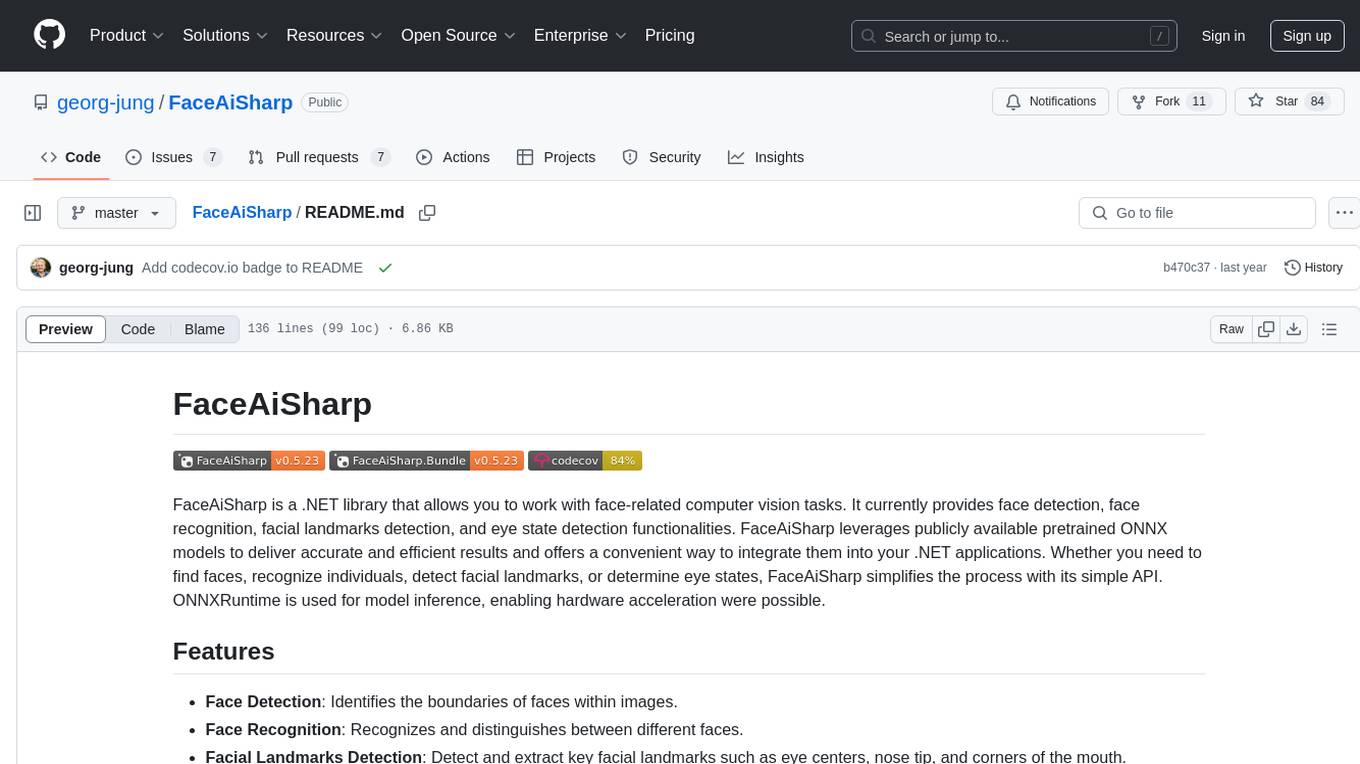
FaceAiSharp
FaceAiSharp is a .NET library designed for face-related computer vision tasks. It offers functionalities such as face detection, face recognition, facial landmarks detection, and eye state detection. The library utilizes pretrained ONNX models for accurate and efficient results, enabling users to integrate these capabilities into their .NET applications easily. With a focus on simplicity and performance, FaceAiSharp provides a local processing solution without relying on cloud services, supporting image-based face processing using ImageSharp. It is cross-platform compatible, supporting Windows, Linux, Android, and more.
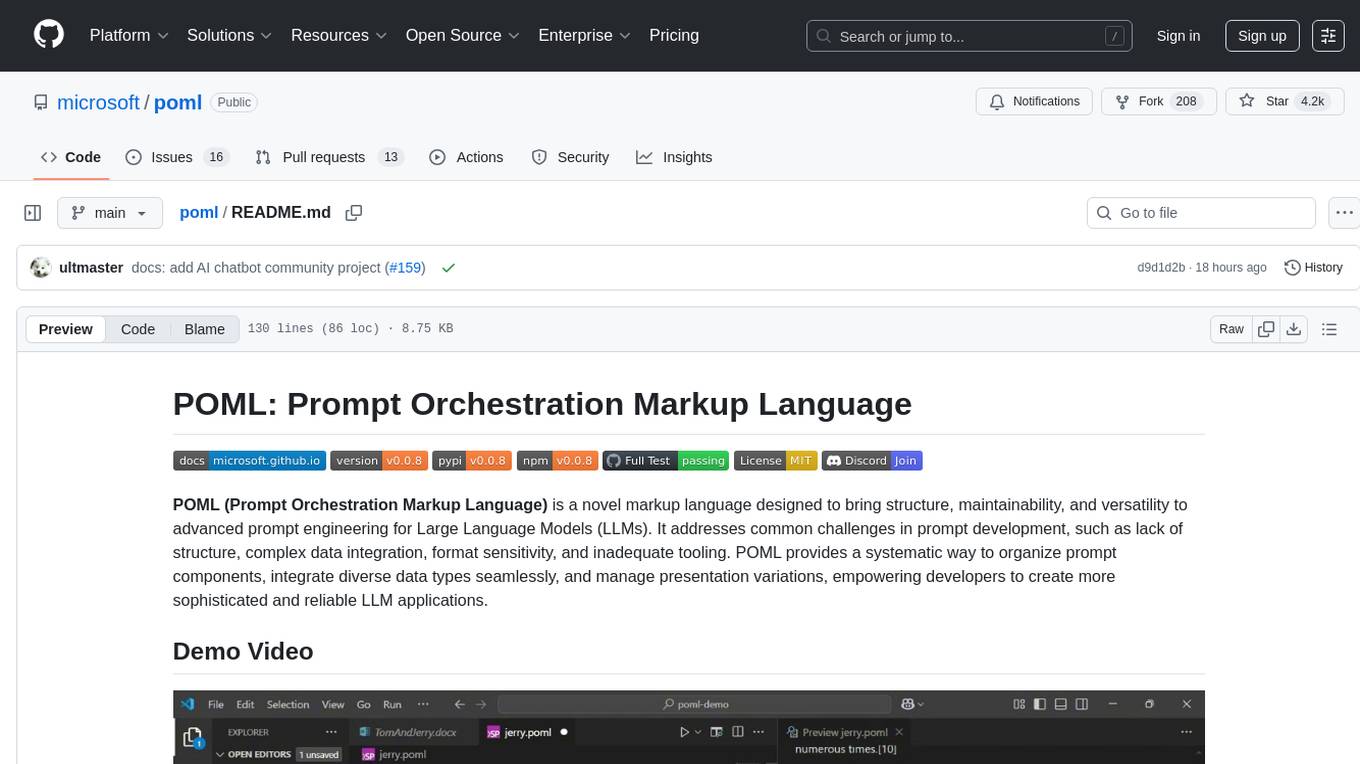
poml
POML (Prompt Orchestration Markup Language) is a novel markup language designed to bring structure, maintainability, and versatility to advanced prompt engineering for Large Language Models (LLMs). It addresses common challenges in prompt development, such as lack of structure, complex data integration, format sensitivity, and inadequate tooling. POML provides a systematic way to organize prompt components, integrate diverse data types seamlessly, and manage presentation variations, empowering developers to create more sophisticated and reliable LLM applications.
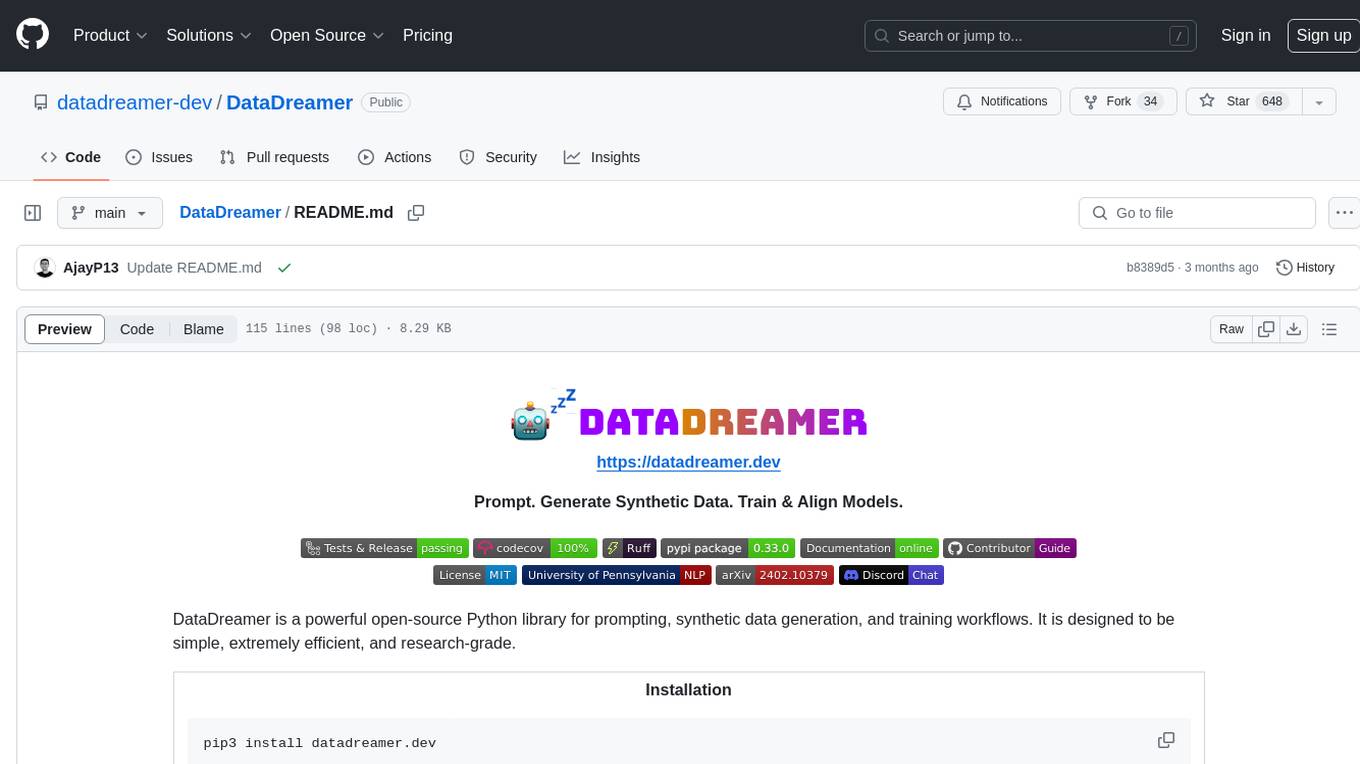
DataDreamer
DataDreamer is a powerful open-source Python library designed for prompting, synthetic data generation, and training workflows. It is simple, efficient, and research-grade, allowing users to create prompting workflows, generate synthetic datasets, and train models with ease. The library is built for researchers, by researchers, focusing on correctness, best practices, and reproducibility. It offers features like aggressive caching, resumability, support for bleeding-edge techniques, and easy sharing of datasets and models. DataDreamer enables users to run multi-step prompting workflows, generate synthetic datasets for various tasks, and train models by aligning, fine-tuning, instruction-tuning, and distilling them using existing or synthetic data.
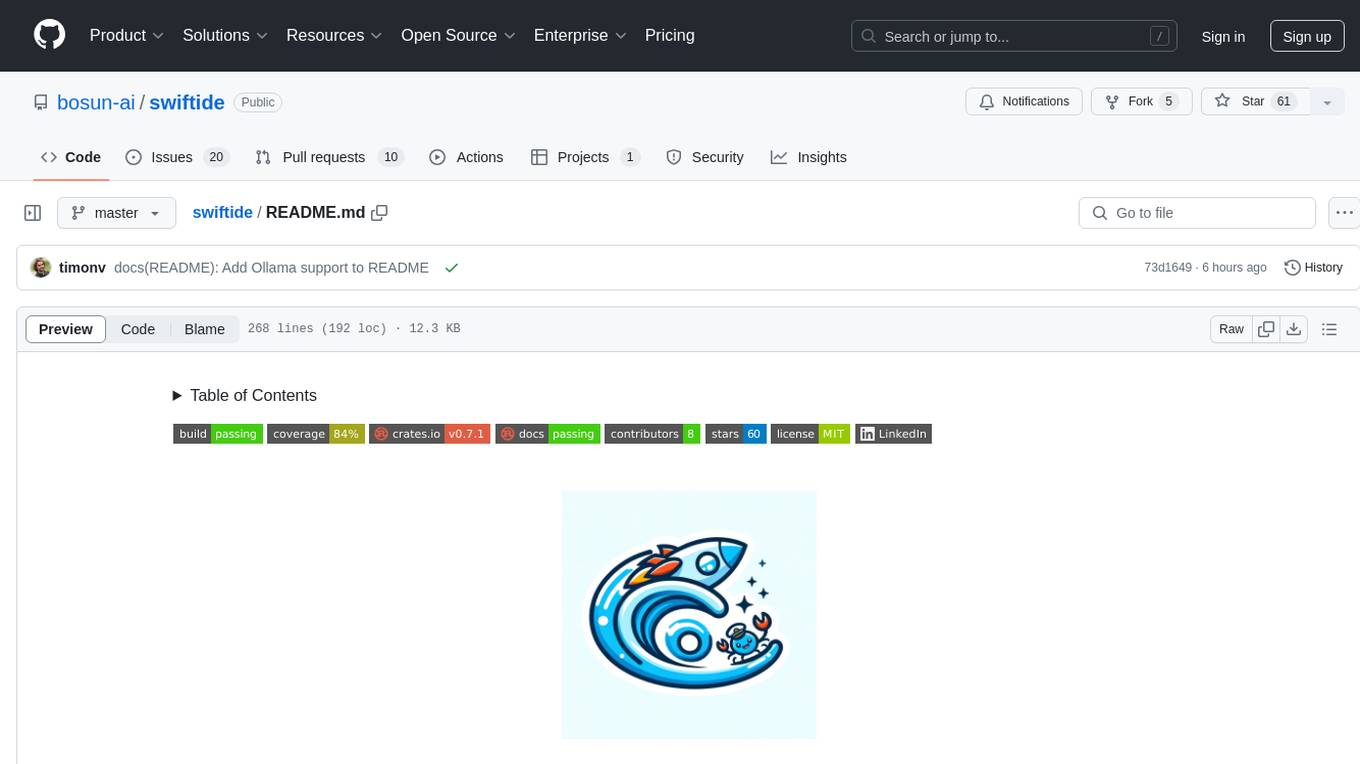
swiftide
Swiftide is a fast, streaming indexing and query library tailored for Retrieval Augmented Generation (RAG) in AI applications. It is built in Rust, utilizing parallel, asynchronous streams for blazingly fast performance. With Swiftide, users can easily build AI applications from idea to production in just a few lines of code. The tool addresses frustrations around performance, stability, and ease of use encountered while working with Python-based tooling. It offers features like fast streaming indexing pipeline, experimental query pipeline, integrations with various platforms, loaders, transformers, chunkers, embedders, and more. Swiftide aims to provide a platform for data indexing and querying to advance the development of automated Large Language Model (LLM) applications.
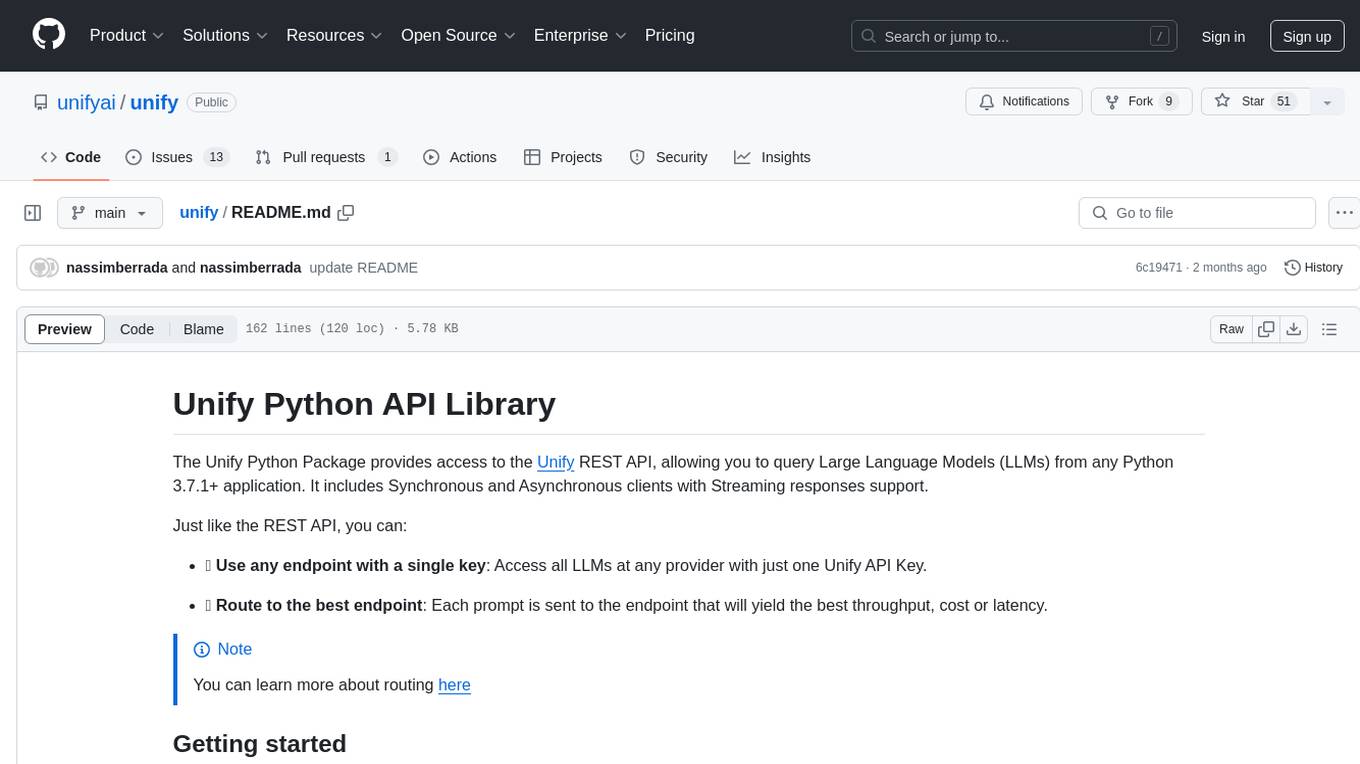
unify
The Unify Python Package provides access to the Unify REST API, allowing users to query Large Language Models (LLMs) from any Python 3.7.1+ application. It includes Synchronous and Asynchronous clients with Streaming responses support. Users can easily use any endpoint with a single key, route to the best endpoint for optimal throughput, cost, or latency, and customize prompts to interact with the models. The package also supports dynamic routing to automatically direct requests to the top-performing provider. Additionally, users can enable streaming responses and interact with the models asynchronously for handling multiple user requests simultaneously.
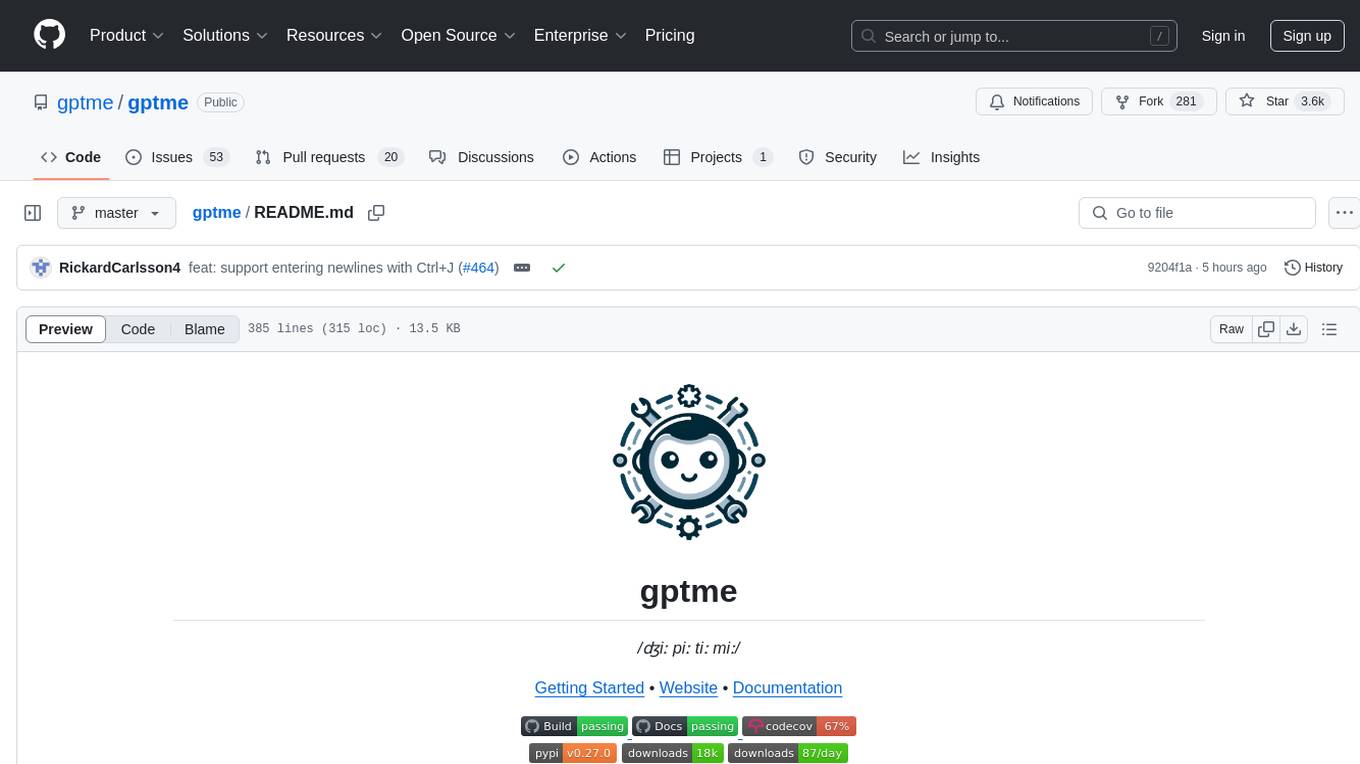
gptme
Personal AI assistant/agent in your terminal, with tools for using the terminal, running code, editing files, browsing the web, using vision, and more. A great coding agent that is general-purpose to assist in all kinds of knowledge work, from a simple but powerful CLI. An unconstrained local alternative to ChatGPT with 'Code Interpreter', Cursor Agent, etc. Not limited by lack of software, internet access, timeouts, or privacy concerns if using local models.
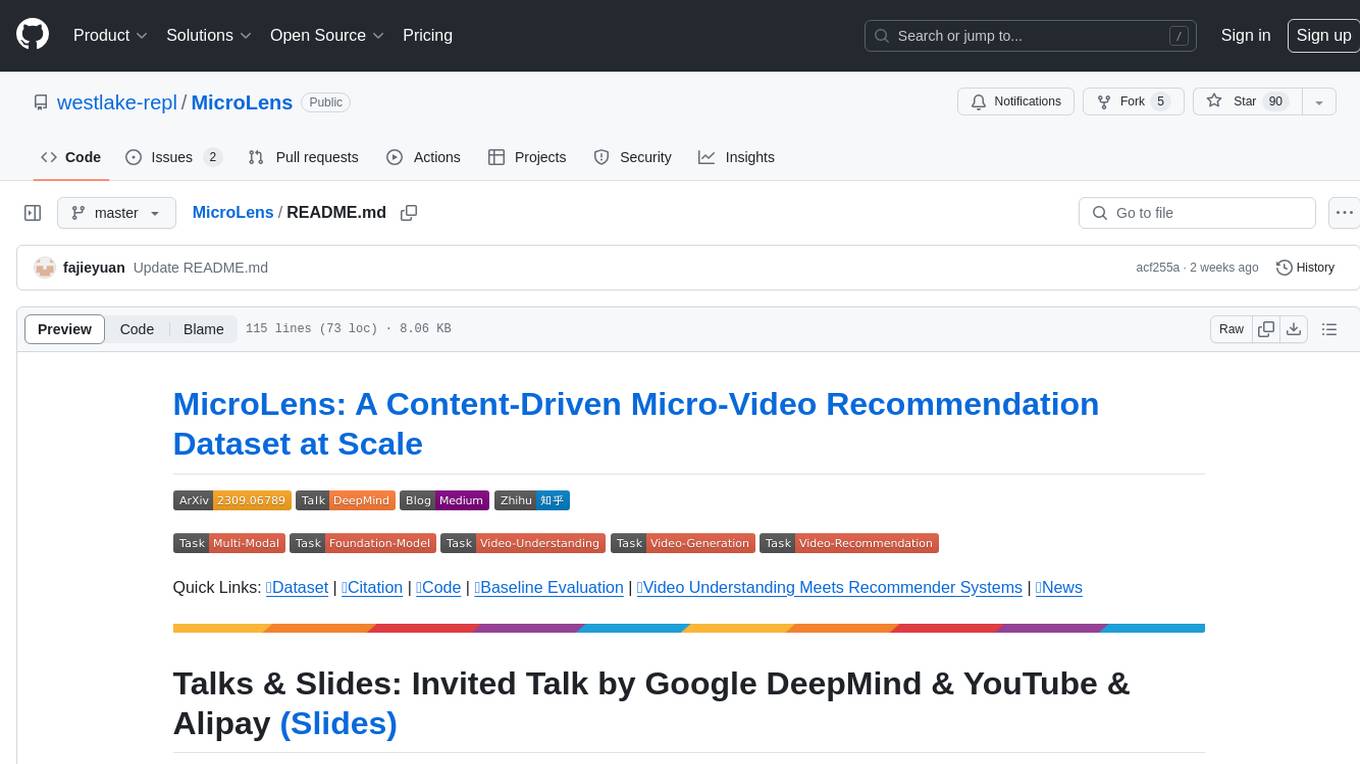
MicroLens
MicroLens is a content-driven micro-video recommendation dataset at scale. It provides a large dataset with multimodal data, including raw text, images, audio, video, and video comments, for tasks such as multi-modal recommendation, foundation model building, and fairness recommendation. The dataset is available in two versions: MicroLens-50K and MicroLens-100K, with extracted features for multimodal recommendation tasks. Researchers can access the dataset through provided links and reach out to the corresponding author for the complete dataset. The repository also includes codes for various algorithms like VideoRec, IDRec, and VIDRec, each implementing different video models and baselines.
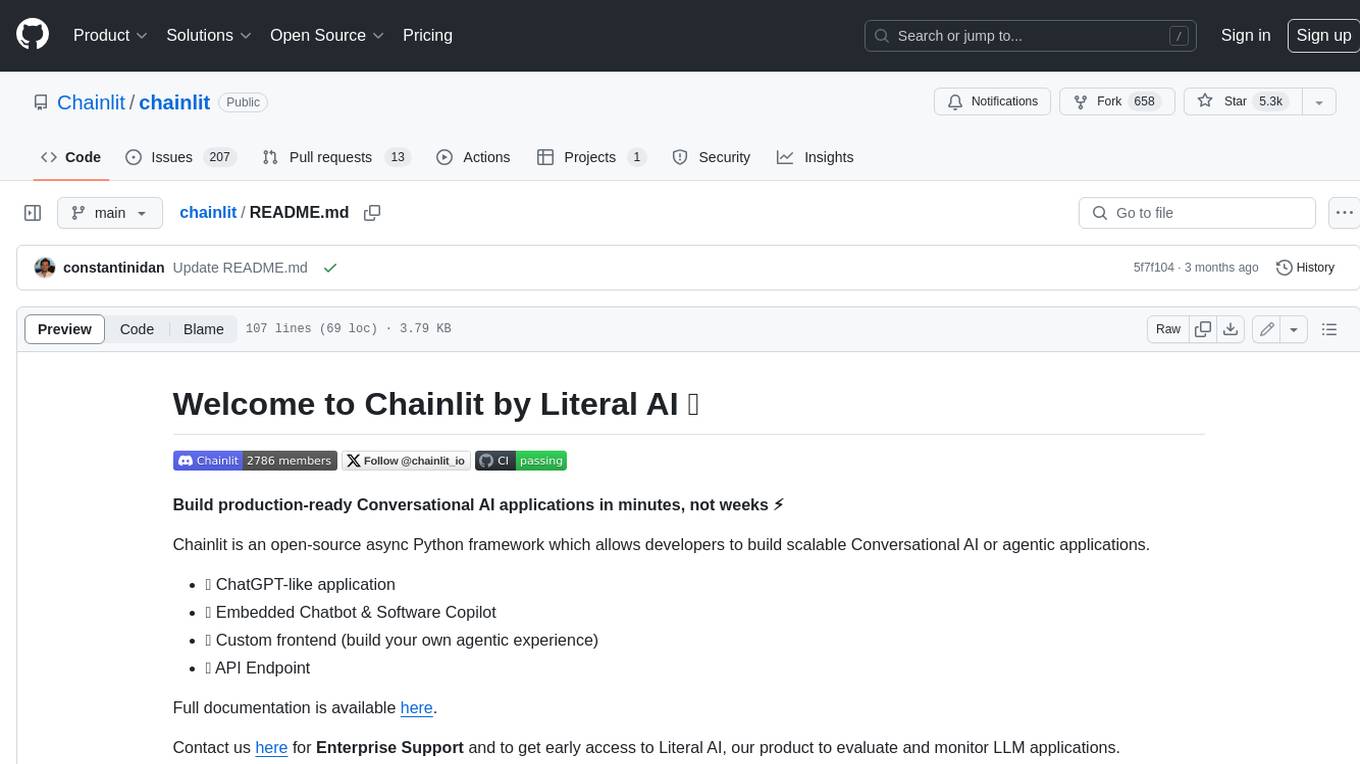
chainlit
Chainlit is an open-source async Python framework which allows developers to build scalable Conversational AI or agentic applications. It enables users to create ChatGPT-like applications, embedded chatbots, custom frontends, and API endpoints. The framework provides features such as multi-modal chats, chain of thought visualization, data persistence, human feedback, and an in-context prompt playground. Chainlit is compatible with various Python programs and libraries, including LangChain, Llama Index, Autogen, OpenAI Assistant, and Haystack. It offers a range of examples and a cookbook to showcase its capabilities and inspire users. Chainlit welcomes contributions and is licensed under the Apache 2.0 license.
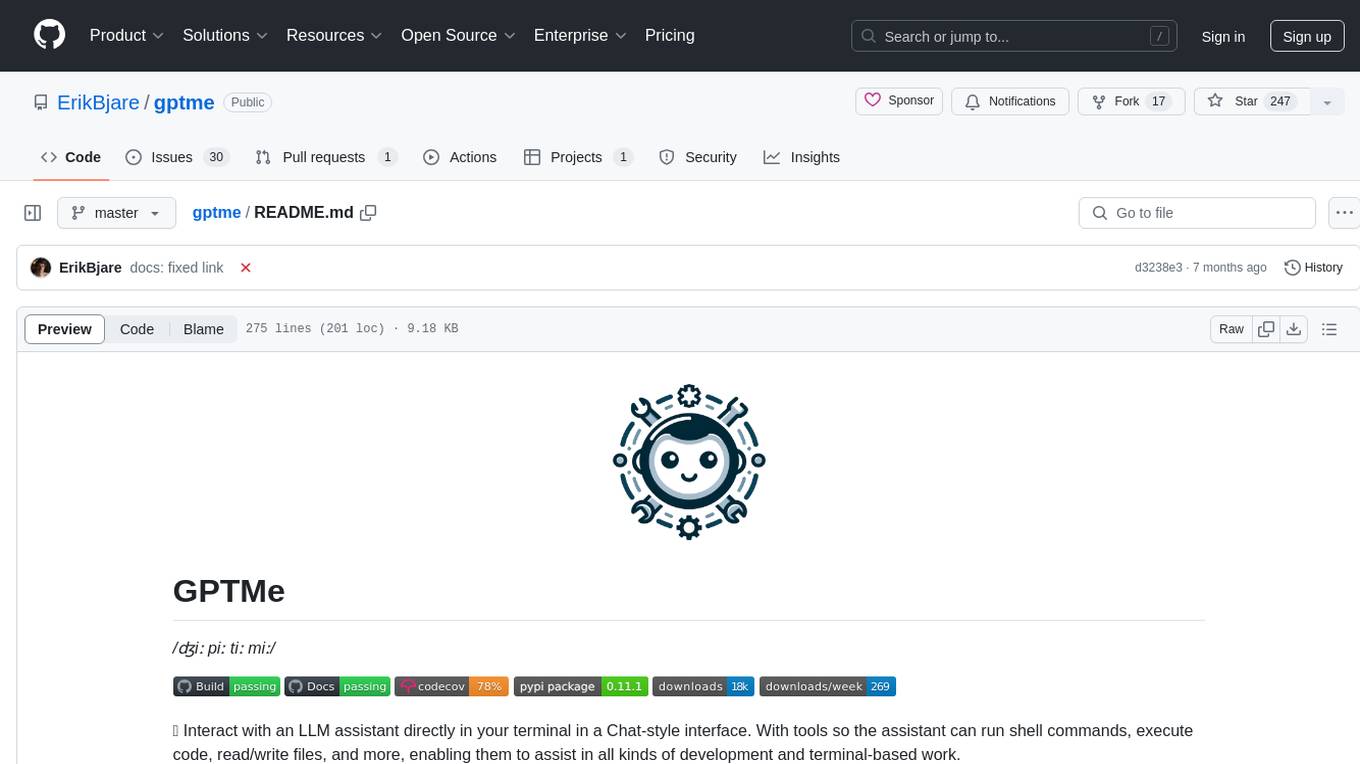
gptme
GPTMe is a tool that allows users to interact with an LLM assistant directly in their terminal in a chat-style interface. The tool provides features for the assistant to run shell commands, execute code, read/write files, and more, making it suitable for various development and terminal-based tasks. It serves as a local alternative to ChatGPT's 'Code Interpreter,' offering flexibility and privacy when using a local model. GPTMe supports code execution, file manipulation, context passing, self-correction, and works with various AI models like GPT-4. It also includes a GitHub Bot for requesting changes and operates entirely in GitHub Actions. In progress features include handling long contexts intelligently, a web UI and API for conversations, web and desktop vision, and a tree-based conversation structure.
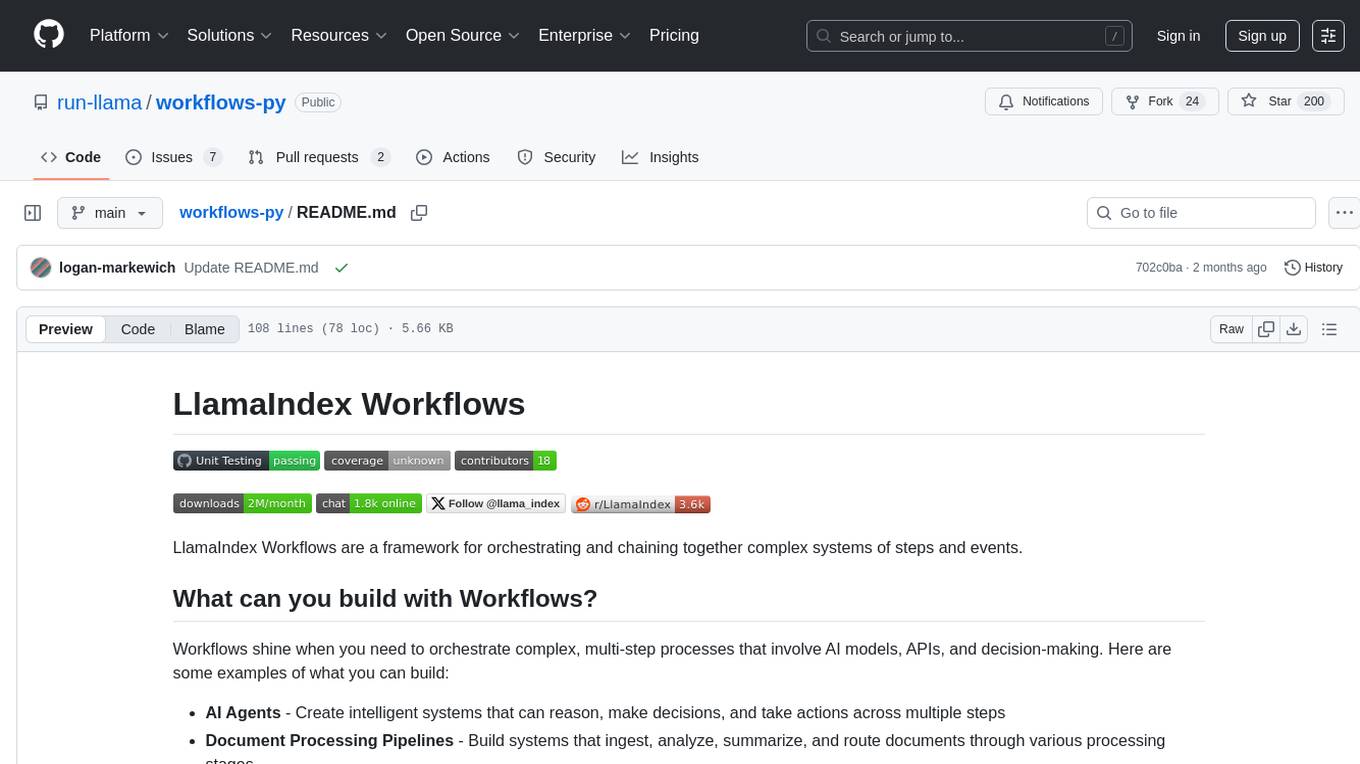
workflows-py
LlamaIndex Workflows is a framework for orchestrating and chaining together complex systems of steps and events. It shines in orchestrating complex, multi-step processes involving AI models, APIs, and decision-making. The async-first, event-driven architecture allows building workflows that can route between different capabilities, implement parallel processing patterns, loop over complex sequences, and maintain state across multiple steps. Key features include async-first design, event-driven structure, state management, and observability through tools like Arize Phoenix and OpenTelemetry.
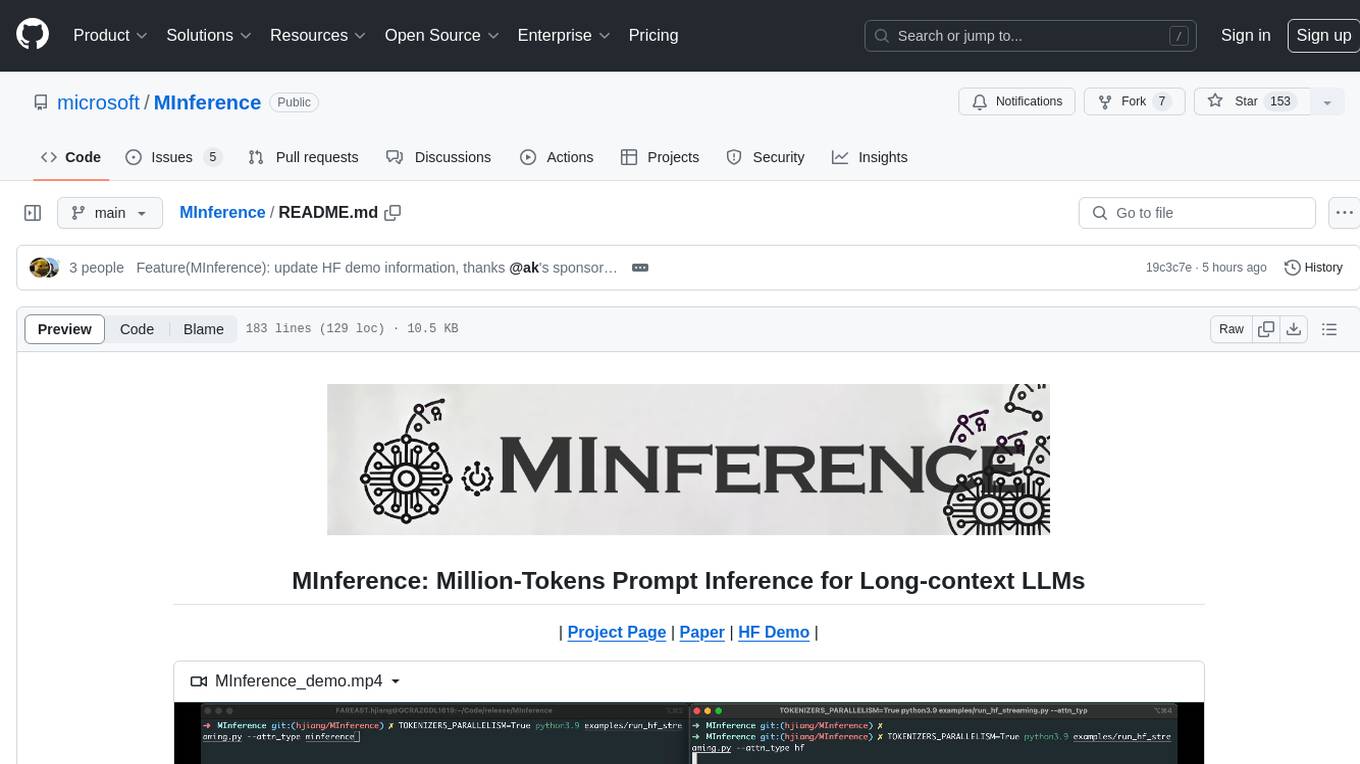
MInference
MInference is a tool designed to accelerate pre-filling for long-context Language Models (LLMs) by leveraging dynamic sparse attention. It achieves up to a 10x speedup for pre-filling on an A100 while maintaining accuracy. The tool supports various decoding LLMs, including LLaMA-style models and Phi models, and provides custom kernels for attention computation. MInference is useful for researchers and developers working with large-scale language models who aim to improve efficiency without compromising accuracy.
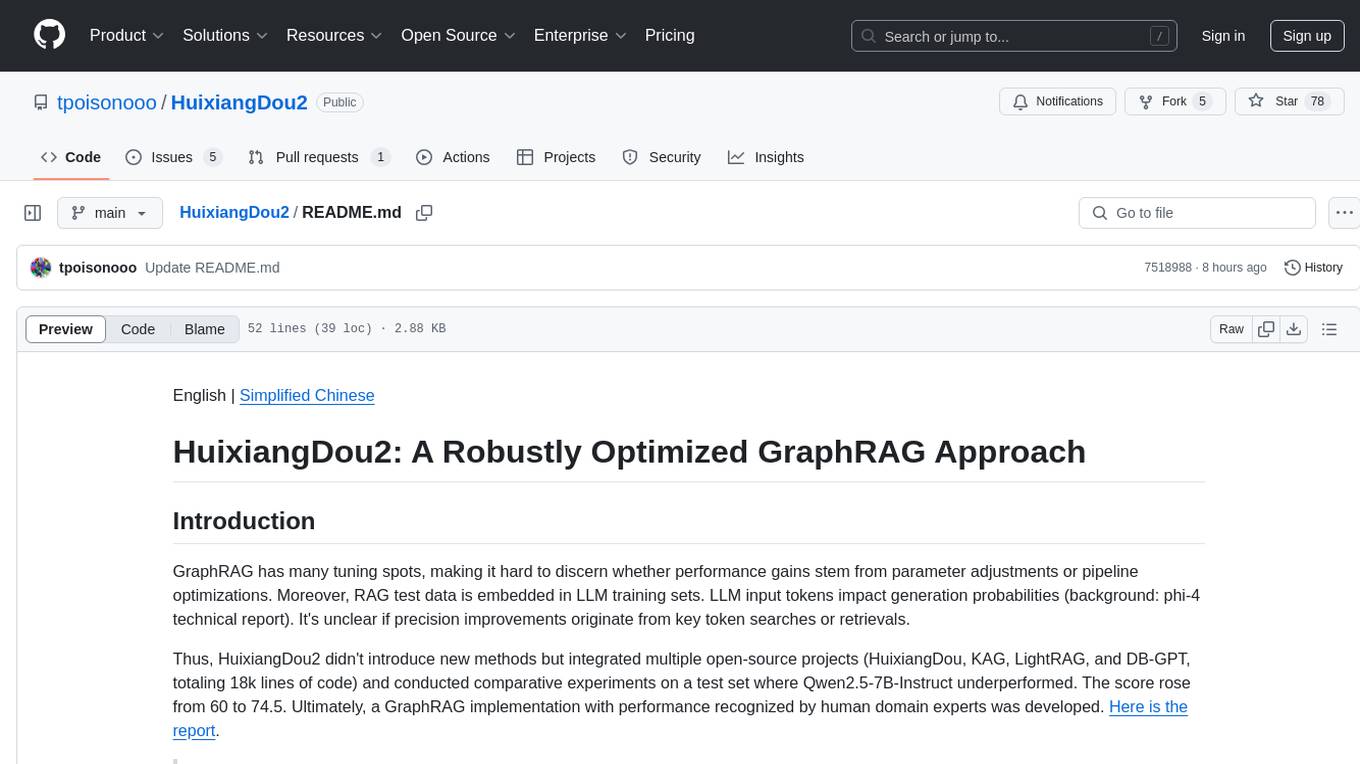
HuixiangDou2
HuixiangDou2 is a robustly optimized GraphRAG approach that integrates multiple open-source projects to improve performance in graph-based augmented generation. It conducts comparative experiments and achieves a significant score increase, leading to a GraphRAG implementation with recognized performance. The repository provides code improvements, dense retrieval for querying entities and relationships, real domain knowledge testing, and impact analysis on accuracy.
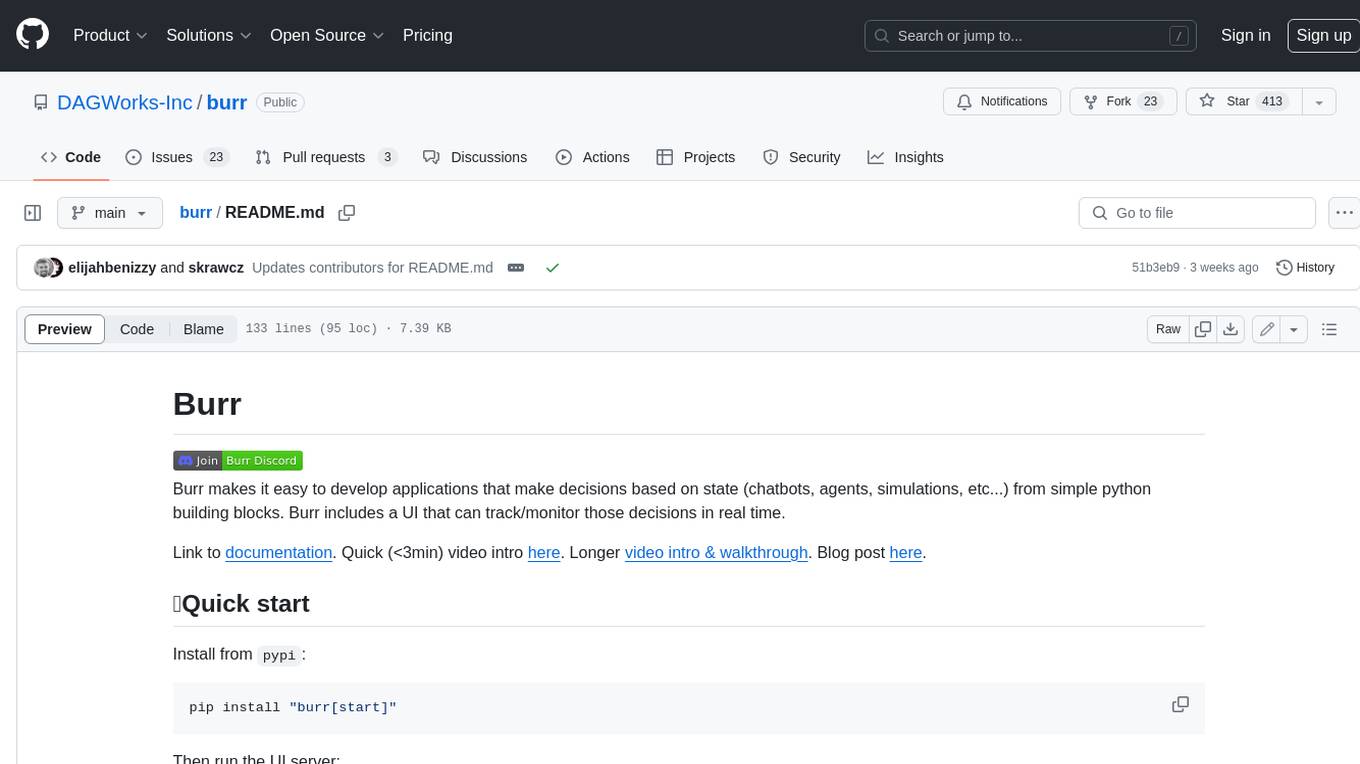
burr
Burr is a Python library and UI that makes it easy to develop applications that make decisions based on state (chatbots, agents, simulations, etc...). Burr includes a UI that can track/monitor those decisions in real time.
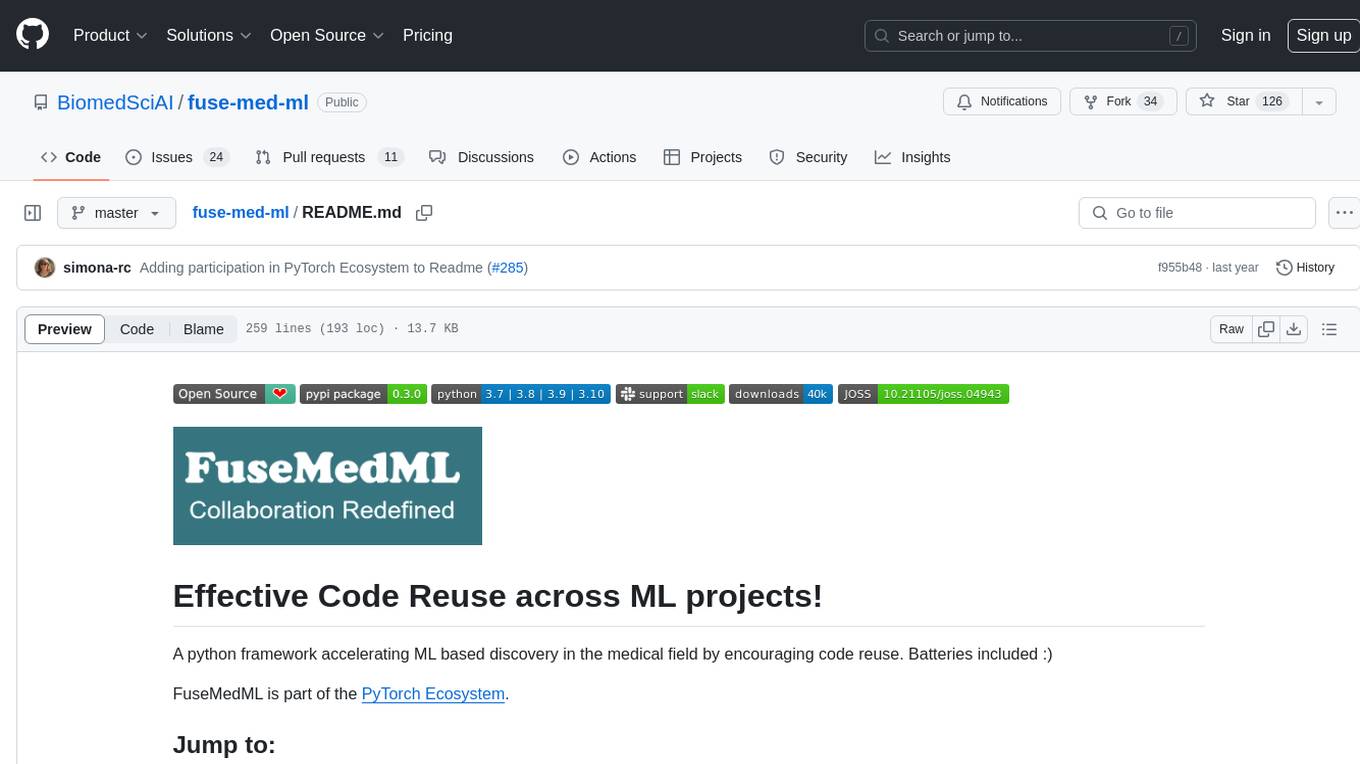
fuse-med-ml
FuseMedML is a Python framework designed to accelerate machine learning-based discovery in the medical field by promoting code reuse. It provides a flexible design concept where data is stored in a nested dictionary, allowing easy handling of multi-modality information. The framework includes components for creating custom models, loss functions, metrics, and data processing operators. Additionally, FuseMedML offers 'batteries included' key components such as fuse.data for data processing, fuse.eval for model evaluation, and fuse.dl for reusable deep learning components. It supports PyTorch and PyTorch Lightning libraries and encourages the creation of domain extensions for specific medical domains.
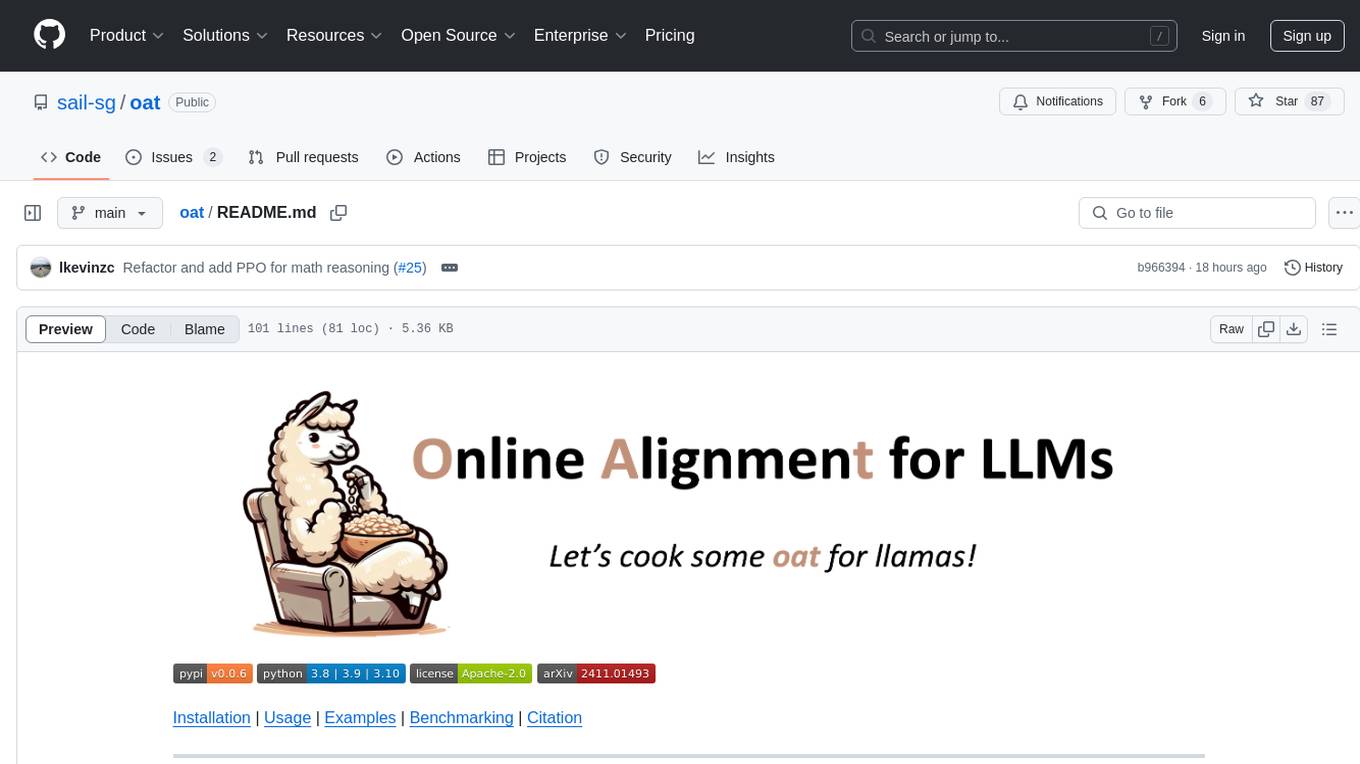
oat
Oat is a simple and efficient framework for running online LLM alignment algorithms. It implements a distributed Actor-Learner-Oracle architecture, with components optimized using state-of-the-art tools. Oat simplifies the experimental pipeline of LLM alignment by serving an Oracle online for preference data labeling and model evaluation. It provides a variety of oracles for simulating feedback and supports verifiable rewards. Oat's modular structure allows for easy inheritance and modification of classes, enabling rapid prototyping and experimentation with new algorithms. The framework implements cutting-edge online algorithms like PPO for math reasoning and various online exploration algorithms.
For similar tasks

griptape
Griptape is a modular Python framework for building AI-powered applications that securely connect to your enterprise data and APIs. It offers developers the ability to maintain control and flexibility at every step. Griptape's core components include Structures (Agents, Pipelines, and Workflows), Tasks, Tools, Memory (Conversation Memory, Task Memory, and Meta Memory), Drivers (Prompt and Embedding Drivers, Vector Store Drivers, Image Generation Drivers, Image Query Drivers, SQL Drivers, Web Scraper Drivers, and Conversation Memory Drivers), Engines (Query Engines, Extraction Engines, Summary Engines, Image Generation Engines, and Image Query Engines), and additional components (Rulesets, Loaders, Artifacts, Chunkers, and Tokenizers). Griptape enables developers to create AI-powered applications with ease and efficiency.
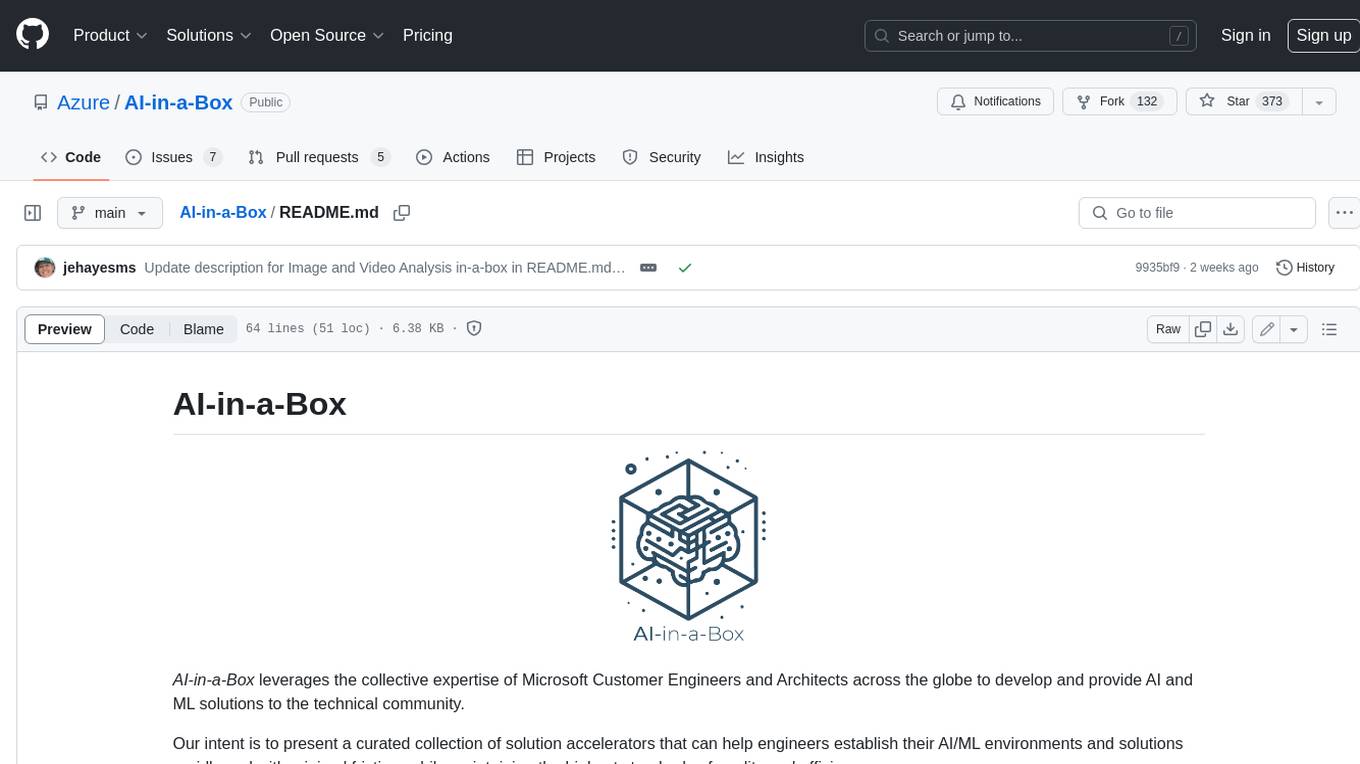
AI-in-a-Box
AI-in-a-Box is a curated collection of solution accelerators that can help engineers establish their AI/ML environments and solutions rapidly and with minimal friction, while maintaining the highest standards of quality and efficiency. It provides essential guidance on the responsible use of AI and LLM technologies, specific security guidance for Generative AI (GenAI) applications, and best practices for scaling OpenAI applications within Azure. The available accelerators include: Azure ML Operationalization in-a-box, Edge AI in-a-box, Doc Intelligence in-a-box, Image and Video Analysis in-a-box, Cognitive Services Landing Zone in-a-box, Semantic Kernel Bot in-a-box, NLP to SQL in-a-box, Assistants API in-a-box, and Assistants API Bot in-a-box.
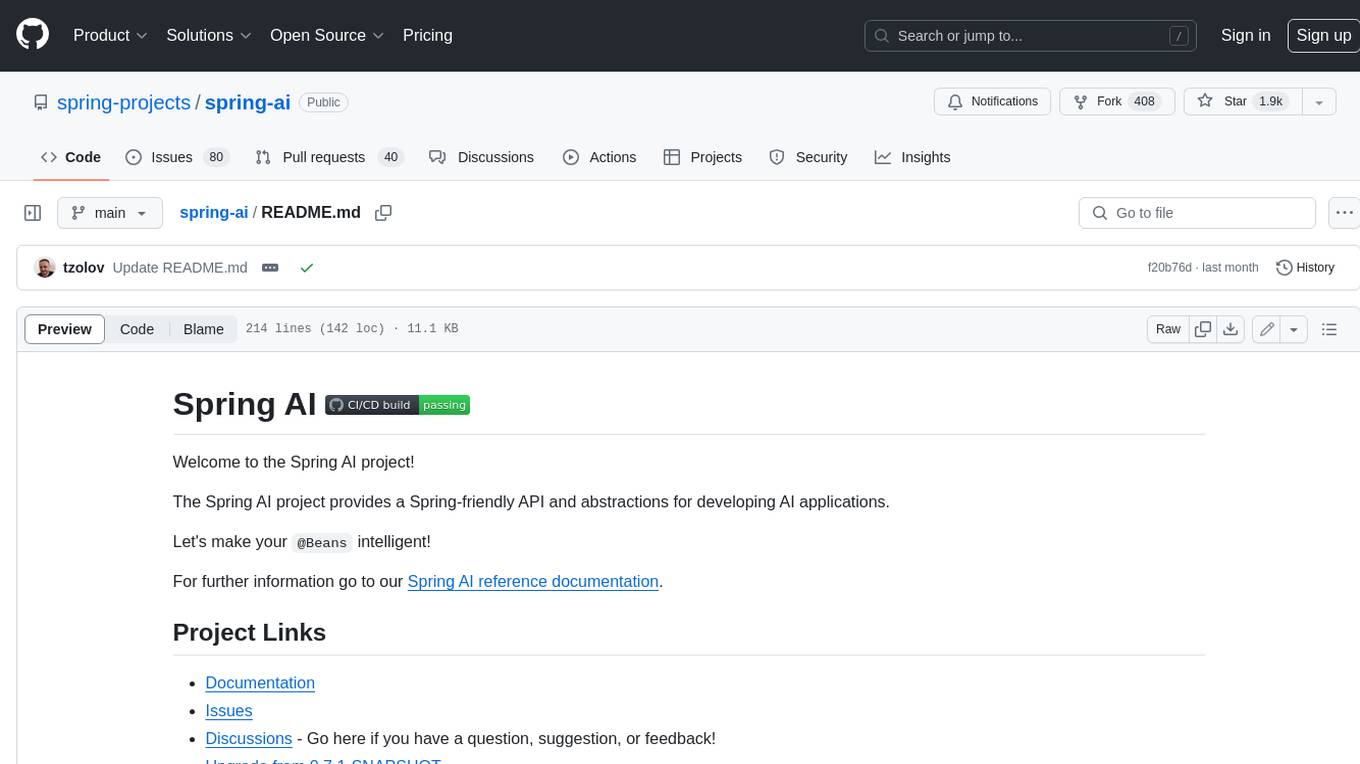
spring-ai
The Spring AI project provides a Spring-friendly API and abstractions for developing AI applications. It offers a portable client API for interacting with generative AI models, enabling developers to easily swap out implementations and access various models like OpenAI, Azure OpenAI, and HuggingFace. Spring AI also supports prompt engineering, providing classes and interfaces for creating and parsing prompts, as well as incorporating proprietary data into generative AI without retraining the model. This is achieved through Retrieval Augmented Generation (RAG), which involves extracting, transforming, and loading data into a vector database for use by AI models. Spring AI's VectorStore abstraction allows for seamless transitions between different vector database implementations.
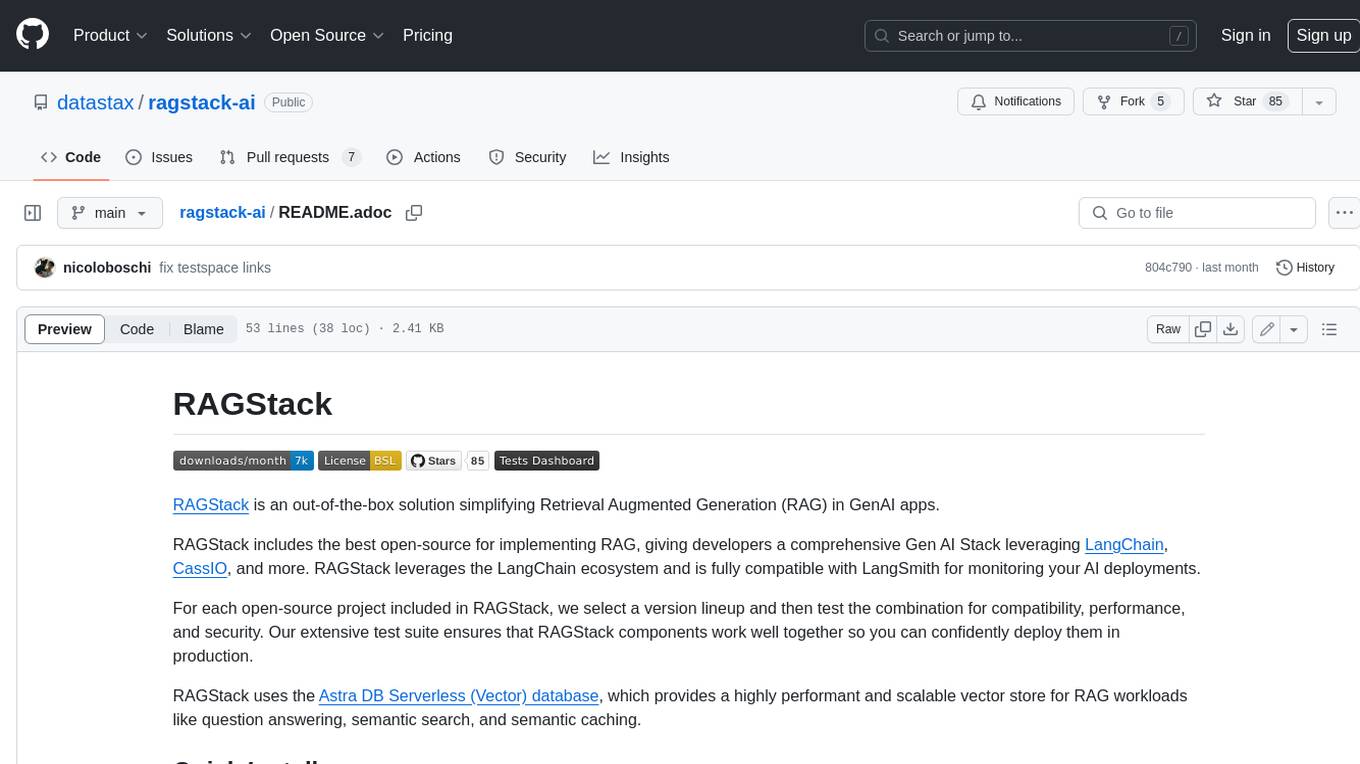
ragstack-ai
RAGStack is an out-of-the-box solution simplifying Retrieval Augmented Generation (RAG) in GenAI apps. RAGStack includes the best open-source for implementing RAG, giving developers a comprehensive Gen AI Stack leveraging LangChain, CassIO, and more. RAGStack leverages the LangChain ecosystem and is fully compatible with LangSmith for monitoring your AI deployments.
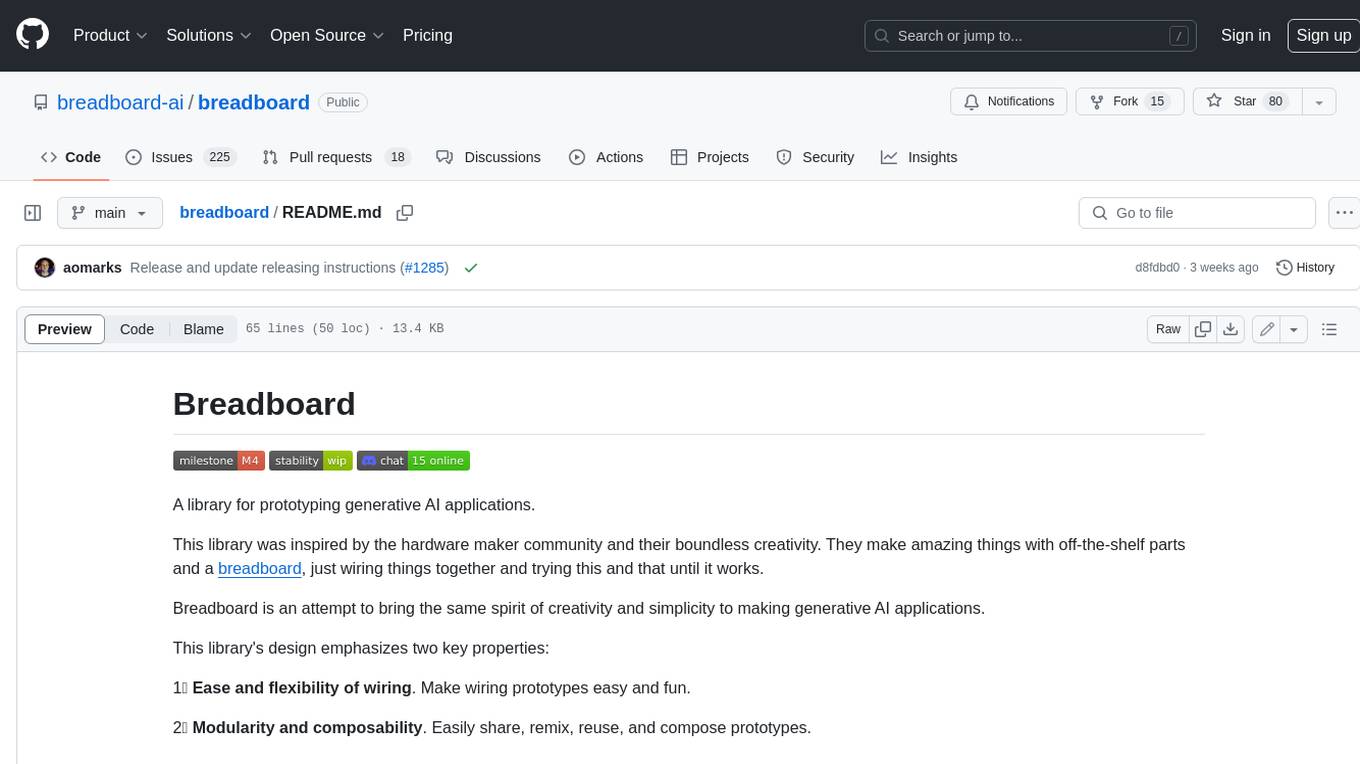
breadboard
Breadboard is a library for prototyping generative AI applications. It is inspired by the hardware maker community and their boundless creativity. Breadboard makes it easy to wire prototypes and share, remix, reuse, and compose them. The library emphasizes ease and flexibility of wiring, as well as modularity and composability.
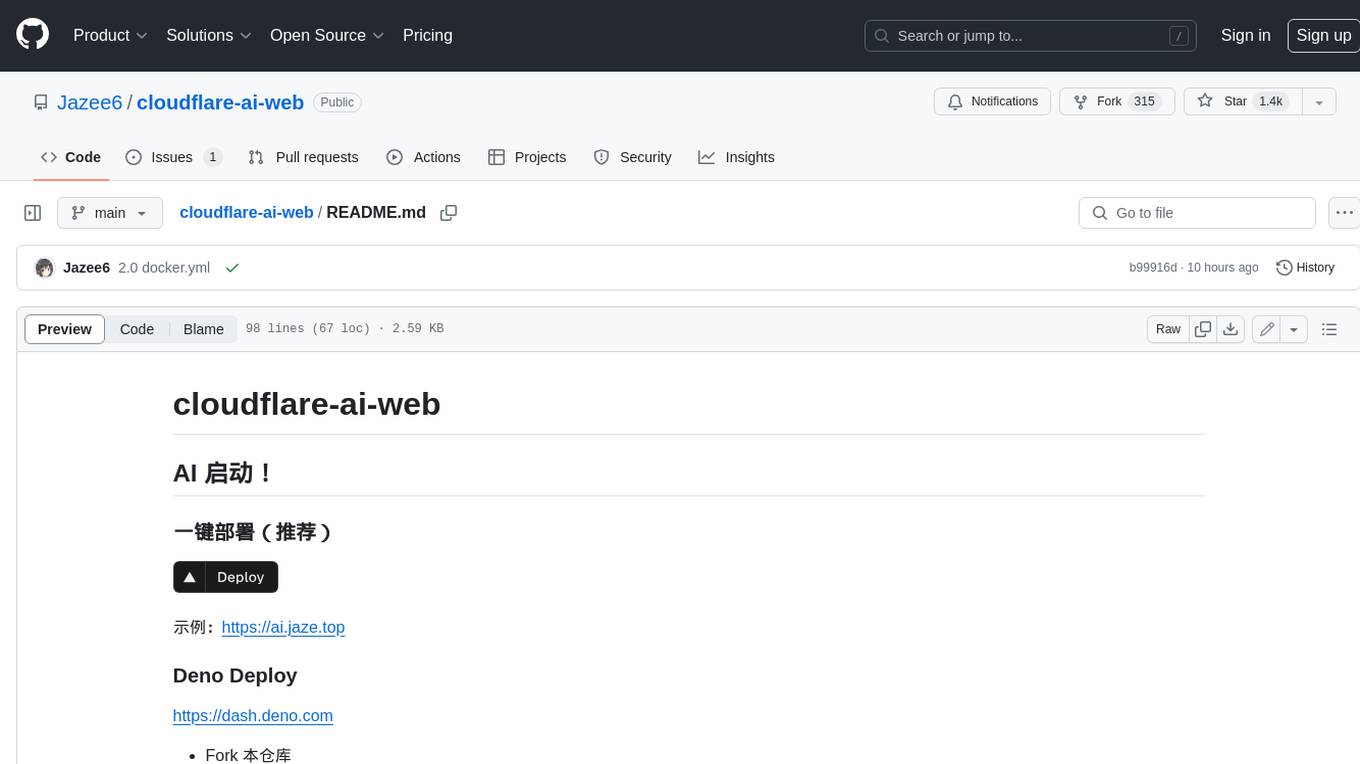
cloudflare-ai-web
Cloudflare-ai-web is a lightweight and easy-to-use tool that allows you to quickly deploy a multi-modal AI platform using Cloudflare Workers AI. It supports serverless deployment, password protection, and local storage of chat logs. With a size of only ~638 kB gzip, it is a great option for building AI-powered applications without the need for a dedicated server.
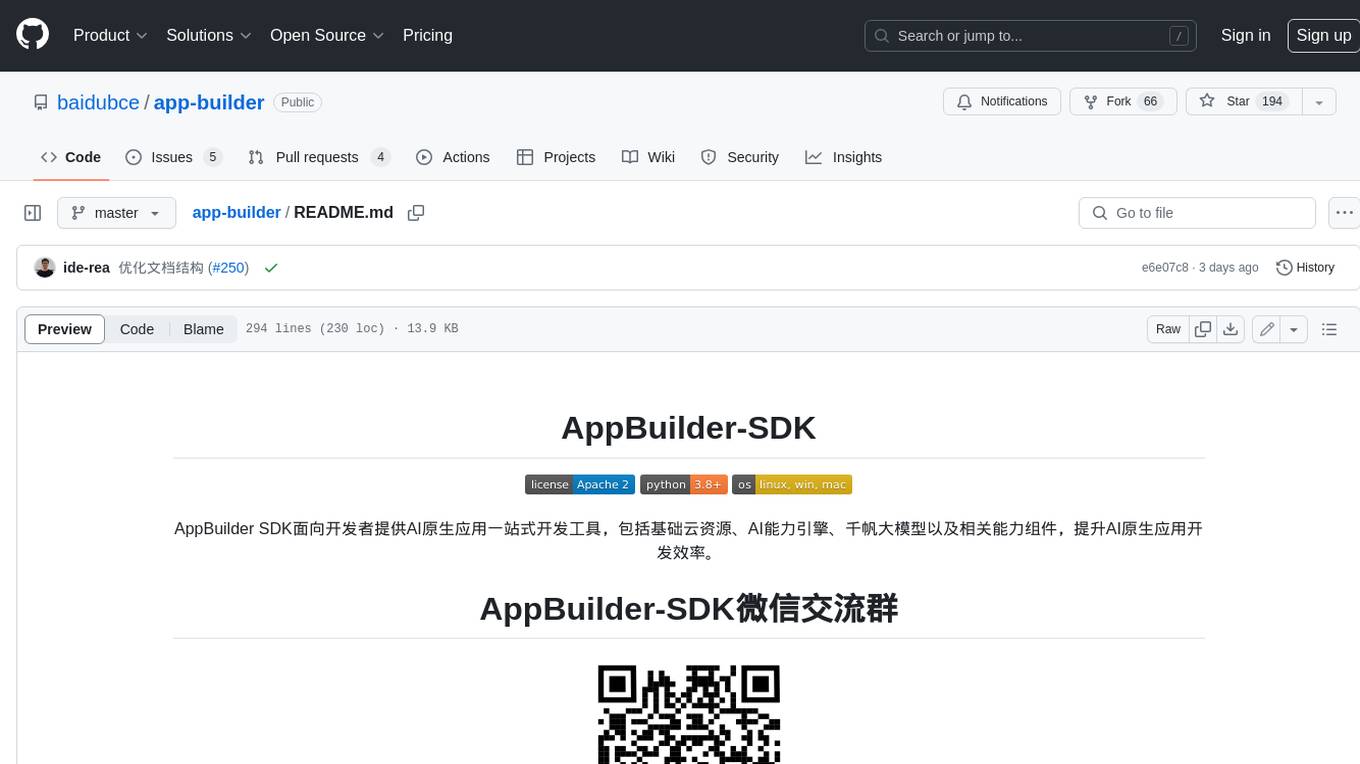
app-builder
AppBuilder SDK is a one-stop development tool for AI native applications, providing basic cloud resources, AI capability engine, Qianfan large model, and related capability components to improve the development efficiency of AI native applications.
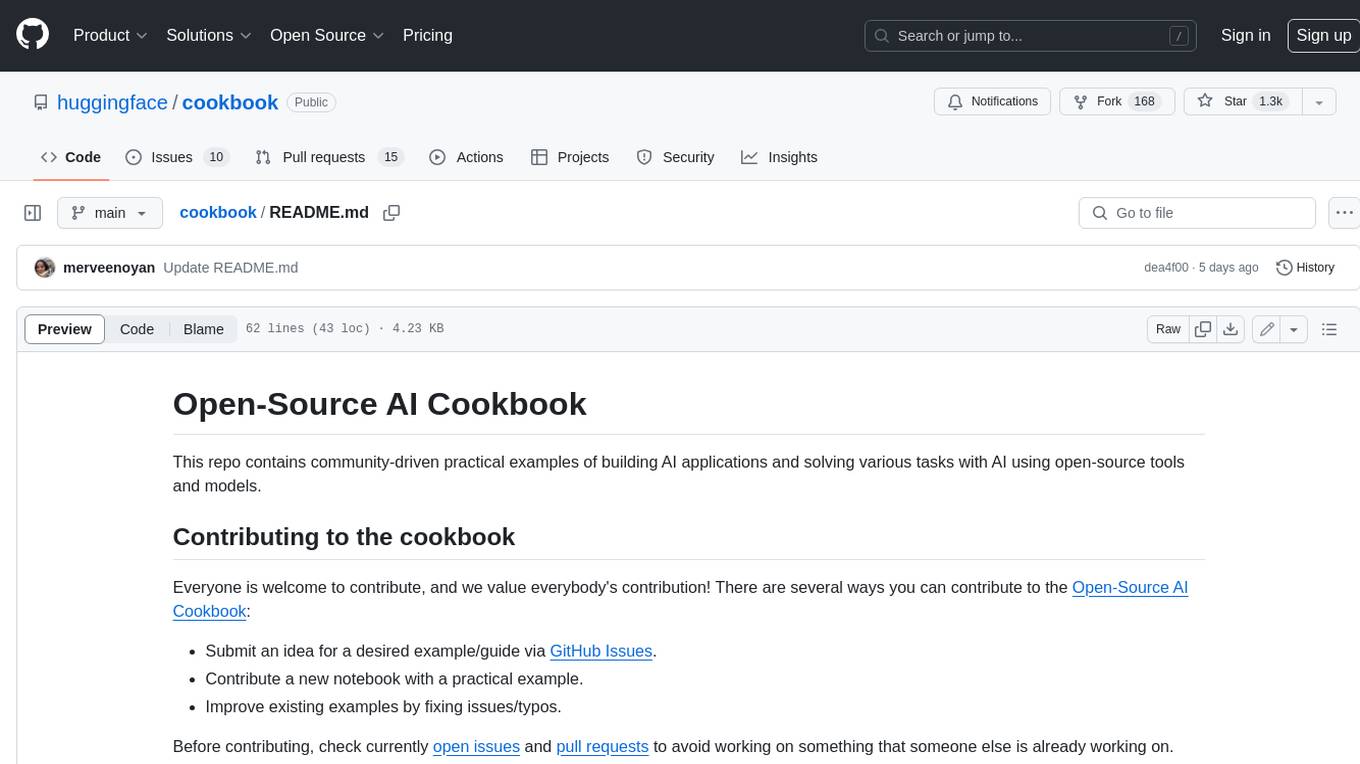
cookbook
This repository contains community-driven practical examples of building AI applications and solving various tasks with AI using open-source tools and models. Everyone is welcome to contribute, and we value everybody's contribution! There are several ways you can contribute to the Open-Source AI Cookbook: Submit an idea for a desired example/guide via GitHub Issues. Contribute a new notebook with a practical example. Improve existing examples by fixing issues/typos. Before contributing, check currently open issues and pull requests to avoid working on something that someone else is already working on.
For similar jobs
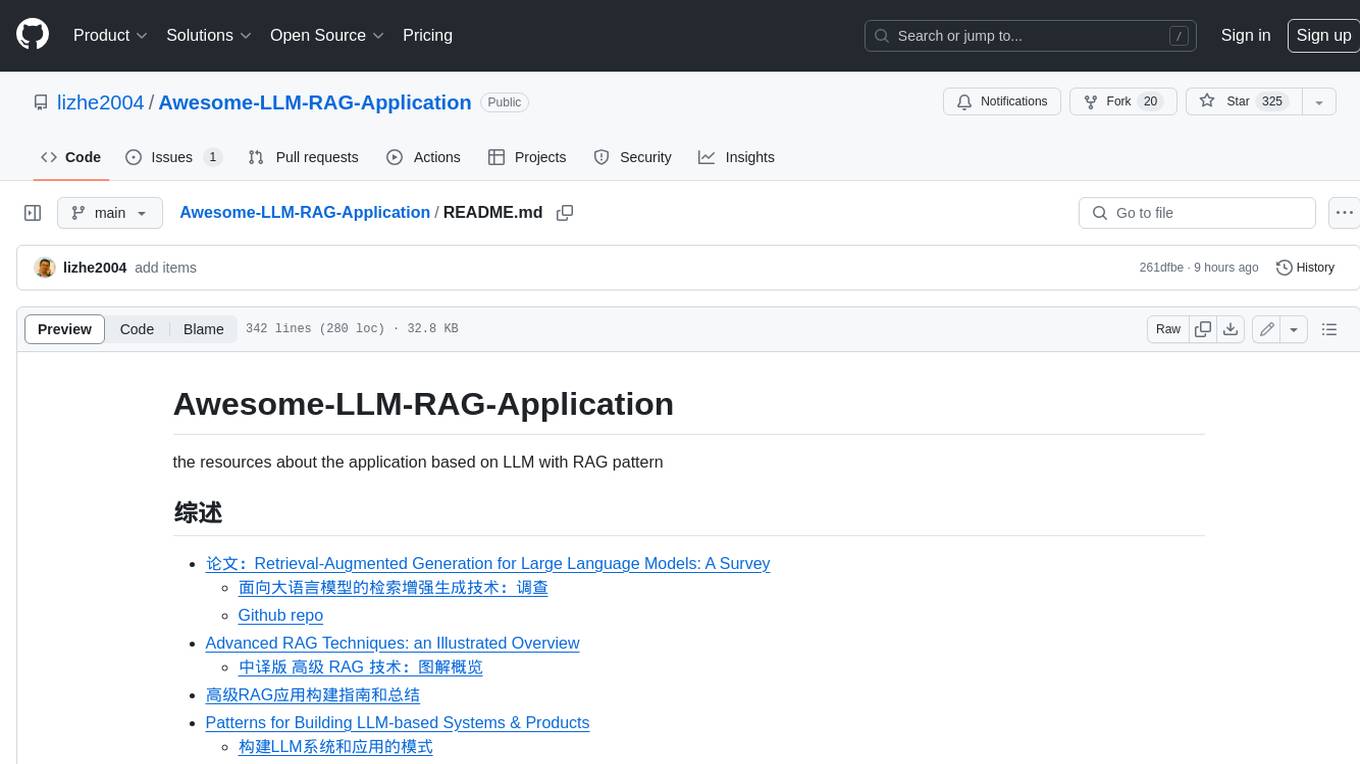
Awesome-LLM-RAG-Application
Awesome-LLM-RAG-Application is a repository that provides resources and information about applications based on Large Language Models (LLM) with Retrieval-Augmented Generation (RAG) pattern. It includes a survey paper, GitHub repo, and guides on advanced RAG techniques. The repository covers various aspects of RAG, including academic papers, evaluation benchmarks, downstream tasks, tools, and technologies. It also explores different frameworks, preprocessing tools, routing mechanisms, evaluation frameworks, embeddings, security guardrails, prompting tools, SQL enhancements, LLM deployment, observability tools, and more. The repository aims to offer comprehensive knowledge on RAG for readers interested in exploring and implementing LLM-based systems and products.
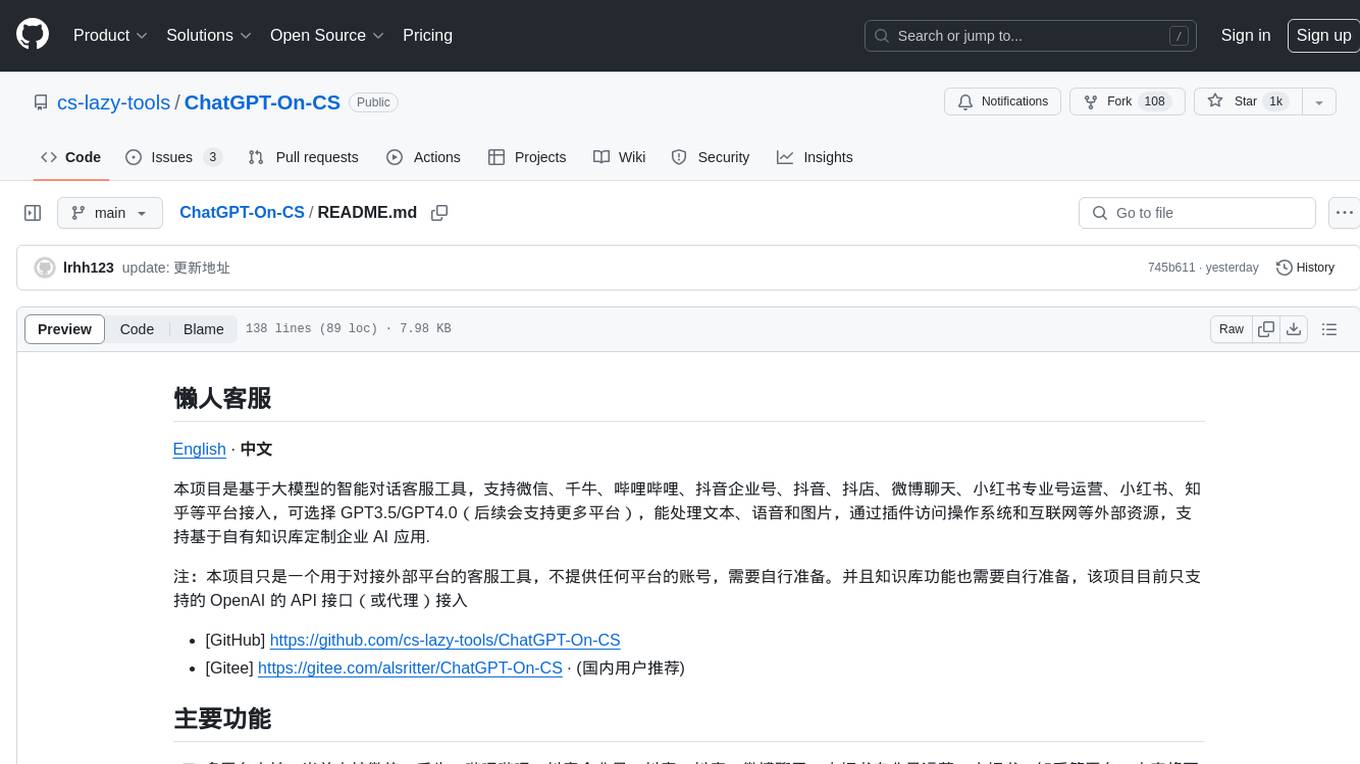
ChatGPT-On-CS
ChatGPT-On-CS is an intelligent chatbot tool based on large models, supporting various platforms like WeChat, Taobao, Bilibili, Douyin, Weibo, and more. It can handle text, voice, and image inputs, access external resources through plugins, and customize enterprise AI applications based on proprietary knowledge bases. Users can set custom replies, utilize ChatGPT interface for intelligent responses, send images and binary files, and create personalized chatbots using knowledge base files. The tool also features platform-specific plugin systems for accessing external resources and supports enterprise AI applications customization.

call-gpt
Call GPT is a voice application that utilizes Deepgram for Speech to Text, elevenlabs for Text to Speech, and OpenAI for GPT prompt completion. It allows users to chat with ChatGPT on the phone, providing better transcription, understanding, and speaking capabilities than traditional IVR systems. The app returns responses with low latency, allows user interruptions, maintains chat history, and enables GPT to call external tools. It coordinates data flow between Deepgram, OpenAI, ElevenLabs, and Twilio Media Streams, enhancing voice interactions.

awesome-LLM-resourses
A comprehensive repository of resources for Chinese large language models (LLMs), including data processing tools, fine-tuning frameworks, inference libraries, evaluation platforms, RAG engines, agent frameworks, books, courses, tutorials, and tips. The repository covers a wide range of tools and resources for working with LLMs, from data labeling and processing to model fine-tuning, inference, evaluation, and application development. It also includes resources for learning about LLMs through books, courses, and tutorials, as well as insights and strategies from building with LLMs.

tappas
Hailo TAPPAS is a set of full application examples that implement pipeline elements and pre-trained AI tasks. It demonstrates Hailo's system integration scenarios on predefined systems, aiming to accelerate time to market, simplify integration with Hailo's runtime SW stack, and provide a starting point for customers to fine-tune their applications. The tool supports both Hailo-15 and Hailo-8, offering various example applications optimized for different common hosts. TAPPAS includes pipelines for single network, two network, and multi-stream processing, as well as high-resolution processing via tiling. It also provides example use case pipelines like License Plate Recognition and Multi-Person Multi-Camera Tracking. The tool is regularly updated with new features, bug fixes, and platform support.

cloudflare-rag
This repository provides a fullstack example of building a Retrieval Augmented Generation (RAG) app with Cloudflare. It utilizes Cloudflare Workers, Pages, D1, KV, R2, AI Gateway, and Workers AI. The app features streaming interactions to the UI, hybrid RAG with Full-Text Search and Vector Search, switchable providers using AI Gateway, per-IP rate limiting with Cloudflare's KV, OCR within Cloudflare Worker, and Smart Placement for workload optimization. The development setup requires Node, pnpm, and wrangler CLI, along with setting up necessary primitives and API keys. Deployment involves setting up secrets and deploying the app to Cloudflare Pages. The project implements a Hybrid Search RAG approach combining Full Text Search against D1 and Hybrid Search with embeddings against Vectorize to enhance context for the LLM.
pixeltable
Pixeltable is a Python library designed for ML Engineers and Data Scientists to focus on exploration, modeling, and app development without the need to handle data plumbing. It provides a declarative interface for working with text, images, embeddings, and video, enabling users to store, transform, index, and iterate on data within a single table interface. Pixeltable is persistent, acting as a database unlike in-memory Python libraries such as Pandas. It offers features like data storage and versioning, combined data and model lineage, indexing, orchestration of multimodal workloads, incremental updates, and automatic production-ready code generation. The tool emphasizes transparency, reproducibility, cost-saving through incremental data changes, and seamless integration with existing Python code and libraries.

wave-apps
Wave Apps is a directory of sample applications built on H2O Wave, allowing users to build AI apps faster. The apps cover various use cases such as explainable hotel ratings, human-in-the-loop credit risk assessment, mitigating churn risk, online shopping recommendations, and sales forecasting EDA. Users can download, modify, and integrate these sample apps into their own projects to learn about app development and AI model deployment.












